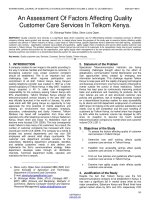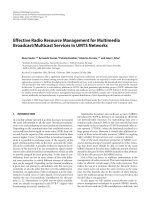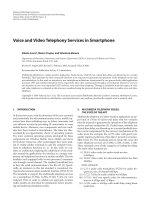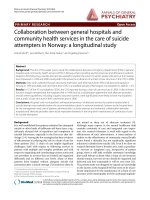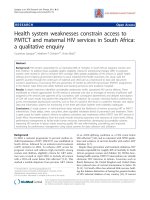services in WiMAX
Bạn đang xem bản rút gọn của tài liệu. Xem và tải ngay bản đầy đủ của tài liệu tại đây (1.26 MB, 64 trang )
Evaluation of existing algorithms scheduling for Real-Time service flows for WiMAX uplink
Tables of Contents
Tables of Contents .......................................................................................................... 1
Acknowledgements ........................................................................................................ 4
List of figures ................................................................................................................. 4
List of tables ................................................................................................................... 5
Glossary ......................................................................................................................... 6
Acronyms ....................................................................................................................... 8
Chapter 1. ..................................................................................................................... 11
1.1 Quality of Service Fundamentals ........................................................................ 12
1.2 QoS in IEEE 802.16 ............................................................................................ 14
1.2.1 Admission Control ....................................................................................... 15
1.2.2 Scheduling .................................................................................................. 16
1.3 Research Motivation and objectives .................................................................... 16
1.4 Thesis organization ............................................................................................. 17
Chapter 2. IEEE 802.16 Standards ................................................................................ 18
2.1 Protocol layer in 802.16 ...................................................................................... 18
2.1.1 Physical layer ............................................................................................... 18
2.1.2 MAC Layer .................................................................................................. 20
2.2 Admission Control .............................................................................................. 23
2.2.1. Objective ..................................................................................................... 24
2.2.2 Overview of Admission Control ................................................................... 24
2.2.3 Admission Control Policy ............................................................................ 24
2.3 Services and service flows .................................................................................. 26
2.3.1 Connections and service flow ....................................................................... 26
2.4 QoS architecture model ....................................................................................... 35
Chapter 3. Scheduling and Admission for Real-Ttime Traffic ..................................... 38
3.1 Scheduling and admission for real-time traffic. ................................................... 38
3.1.2 Loss rate for preemptive EDF ...................................................................... 44
3.1.3 Non-preemptive EDF ................................................................................... 47
3.2 Some current scheduling algorithms for real-time polling services ..................... 49
1
Evaluation of existing algorithms scheduling for Real-Time service flows for WiMAX uplink
3.2.1 EDF Broadband Wireless Access Scheduling Algorithm .............................. 51
3.2.2 Admission Control ....................................................................................... 54
Chapter 4. Simulation Results ....................................................................................... 57
4.1 Theoretical Performance of single queue EDF scheduling algorithms ................. 57
4.2 Simulation of NP-EDF scheduling algorithm for rtPS services in WiMAX ........ 59
4.3 Conclusion .......................................................................................................... 61
References .................................................................................................................... 62
Abstract
Nowadays, the demand for Internet broadband access is growing rapidly, which
results in lots of new standards of accessing Internet broadband. Together with the
2
Evaluation of existing algorithms scheduling for Real-Time service flows for WiMAX uplink
increasing development of traditional wired broadband networks, wireless network
access is expanding more and more. Wireless broadband access standard IEEE 802.16
came into existence as a result of this fact. IEEE 802.16 standards are established for
Wireless Metropolitan Area Network- WMAN, however, the main part of 802.16 packet
scheduling still remains unspecified. This thesis, thus, reviews analytical methods to
evaluate the efficiency of real time system models with the use of single- server queue
that have been used by many researchers. The service principle in the queue is EDF
(Earliest Deadline First). Real-time jobs with exponentially distributed deadlines arrive
according to a Poisson process, all jobs have deadlines until the end of service. The
thesis also introduces a non-preemptive EDF scheduling algorithm and admission
control for real-time polling services in WiMAX.
3
Evaluation of existing algorithms scheduling for Real-Time service flows for WiMAX uplink
Acknowledgements
It has been an honor that I have had the chance to study in the field that I have
been taught and interested in. It was obvious that I had to try my best to finish my work,
but without the help of many people, this could not have been completed.
Firstly, I would like to thank Prof. Dr. Nguyen Dinh Thong from the University
of Technology, Sydney, for his helpful and enthusiastic instructions throughout the
period of time that I worked on this thesis.
I am also very grateful to Mr. Nguyen Quoc Tuan, M.E. of the Department of
Telecommunications, College of Technology, Vietnam National University Hanoi, for
his sincere help and providing the best setting within the time I studied and researched in
the Faculty of Electronics and Telecommunications.
Next, I am very thankful to Dr. Nguyen Thi Minh Tam, Ms. Nguyen Hai Ha,
B.A. and Ms. Tran Thanh Thu, B.A. from the College of Foreign Languages, Vietnam
National University Hanoi, who have helped me correct the English of this thesis.
I would also like to thank all my teachers and peers that helped me during the
time that I have spent here at the university.
Last but not least, I also want to give my sincere thanks to my family who have
constantly supported me during my four years studying far away from home.
Hanoi, date month year 2008
Nguyen Minh Khue
List of figures
4
Evaluation of existing algorithms scheduling for Real-Time service flows for WiMAX uplink
Figure 1.1: Simple scheduling architecture…………………………………………..15
Figure 2.1: TDD frame structure……………………………………………………..23
Figure 2.2: Correspondence between the CID and SFID…………………………….28
Figure 2.3: Illustration of service flows and connections…………………………….28
Figure 2.4: Classification and CID mapping ………………………………………………...32
Figure 2.5: Header suppression at the sending entity ………………………………………...33
Figure 2.6: Header suppression mechanism at the receiving entity…………………………..33
Figure 2.7: Illustration of PHS operation……………………………………………………..35
Figure 2.8: DSC MAC management message used for the signalling of a PHS rule………..36
Figure 2.9 Quality of Service model in IEEE 802.16 ………………………………………..37
Figure 2.10 Service flow transition diagram………………………………………………….39
Figure 2.11 Medium Access Control architecture of the Base and Subscriber Station..........40
Figure 3.1. State-transition-rate diagram for Markov chain M………………………43
Figure 3.2 The modified view to the non-preemptive EDF queue ………………………50
Figure 3.3 Hierarchical structure of bandwidth allocation [24]……………………55
Figure 3.4 rtPS database structure in scheduling database module [24] …………..56
Figure 3.5 Token Bucket mechanism ……………………………………………. ..57
Figure 4.1 P-EDF analytic with µθ=4…………………………………………..........59
Figure 4.2 P-EDF analytic with µθ=8…………………………………………..........60
Figure 4.3 Loss probability analytic….……………………………………………….61
Figure 4.4 Bandwidth allocation for rtPS connection ……………………………. …62
Figure 4.5 Arrival and service curve for rtPS connection ………………………… ..63
List of tables
Table 1: CID ranges as defined in Reference IEEE 802.16-2004…………………..29
Table 2: Possible values of the PHS support field…………………………………..33
5
Evaluation of existing algorithms scheduling for Real-Time service flows for WiMAX uplink
Glossary
Base Station (BS): Generalized equipment set providing connectivity, management,
and control of the subscriber station (SS).
6
Evaluation of existing algorithms scheduling for Real-Time service flows for WiMAX uplink
Broadband: having instantaneous bandwidths greater than around 1MHz and
supporting data rates greater than about 1.5Mbps.
Broadband Wireless Access (BWA): Wireless access in which the connection(s)
capabilities are broadband.
Burst Profile: set of parameters that describe the uplink or downlink transmission
properties associated with an interval usage code. Each profile contains parameters such
as modulation type, forward error correction (FEC) type, preamble length, guard times,
etc.
Connection: A unidirectional mapping between base station (BS) and subscriber station
(SS) medium access control (MAC) peers for the purpose of transporting traffic flow of
a service. Connection are identified by a connection identifier (CID). All traffic is
carried on a connection even for service flows that implement connectionless protocols,
such as Internet Protocol (IP).
Connection Identifier (CID): A 16-bit value that identifiers a connection to equivalent
peers in the MAC of the base station (BS) and subscriber station (SS). It maps to a
service flow identifier (SFID), which defines the Quality of Service (QoS) parameters of
the service flow associated with that connection.
Downlink: The direction from the base station (BS) to the subscriber station (SS).
Downlink Map (DL-MAP): A MAC messages that defines burst start times for both
time division multiple and time division multiple access (TDMA) by a subscriber station
(SS) on the downlink.
Frame: A structured data sequence of fixed duration used by some PHY specifications.
A frame may contain both an uplink subframe and a downlink subframe.
Frequency Division Duplex (FDD): A duplex scheme in which uplink and downlink
transmissions use different frequencies but are typically simultaneous.
Protocol Data Unit (PDU): The data unit exchanged between peer entities of the same
protocol layer. In the downward direction, it is the data unit generated for the next lower
layer. On the upward direction, it is the data unit received from the previous lower layer.
Service Access Point (SAP): The point in a protocol stack where the services of a
lower layer are available to its next higher layer.
7
Evaluation of existing algorithms scheduling for Real-Time service flows for WiMAX uplink
Service Data Unit (SDU): The data unit exchanged between two adjacent protocol
layer. On the downward direction, it is the data unit received from the previous higher
layer. On the upward direction, it is the data unit sent to the next higher layer.
Service Flows (SF): A unidirectional flow of medium access control (MAC) service
data units (SDUs) on a connection that is provided by a particular Quality of Service
(QoS).
Service Flow Identifier (SFID): A 32-bit quantity that uniquely identifiers a service
flow to both the subscriber station (SS) and base station (BS).
Subscriber Station (SS): Generalized equipment set providing connectivity between
subscriber equipment and a base station.
Time Division Duplex (TDD): A duplex scheme where uplink and downlink
transmissions occur at different times about may share the same frequency.
Uplink: The direction from a subscriber station to the base station.
Uplink MAP (UL-MAP): A MAC messages that defines the uplink usage in terms of
the offset the burst relative to the allocation start time (AST).
Acronyms
AAS Adaptive Antenna Systems
8
Evaluation of existing algorithms scheduling for Real-Time service flows for WiMAX uplink
ACK Acknowledgement
AK Authorization Key
ATM Asynchronous Transfer Mode
ARQ Automatic Repeat Request
BE Best Effort
BPI+ Baseline Privacy Interface
BS Base Station
BWA Broadband Wireless Access
CBR Constant Bit Rate
CID Connection Identifier
CP Complete partitioning
CS Complete sharing
DCD Downlink Channel Descriptor
DHCP Dynamic Host Control Protocol
DOCSIS Data Over Cable Service Interface Specification
DSA Dynamic Service Addition
DSC Dynamic Service Creation
DSD Dynamic Service Deletion
ertPS Extended real-time Polling Service
FCFS First Come, First Serve
FIFO First In, First Out
GPC Grant Per Connection
GPSS Grant Per Subscriber Station
HEC Header Error Check
IEEE Institute of Electrical and Electronic Engineers
IP Internet Protocol
LAN Local Area Network
9
Evaluation of existing algorithms scheduling for Real-Time service flows for WiMAX uplink
LoS Line of Sight
MAC Medium Access Control
NLoS Non Line of Sight
nrtPS non-real time Polling Service
PHS Payload Header Suppression
PHSF Payload Header Suppression Field
PHSI Payload Header Suppression Index
PHSM Payload Header Suppression Mask
PHSV Payload Header Suppression Valid
PHSS Payload Header Suppression Size
PKM Privacy Key Management
PHY Physical Layer
PMP Point to Multipoint
QoS Quality of Service
SAP Service Access Point
SFID Service Flow Identifier
SNMP Simple Network Management Protocol
SS Subscriber Station
TDMA Time Division Multiple Access
TDD Time Division Duplexing
TFTP Trivial File Transfer Protocol
VBR Variable Bit Rate
VoIP Voice Over IP
RLC Radio Link Control
RTG Receive/Transmit Transition Gap
RTP Real-Time Protocol
rtPS real-time Polling Service
10
Evaluation of existing algorithms scheduling for Real-Time service flows for WiMAX uplink
UCD Uplink Channel Descriptor
UDP User Datagram Protocol
WiMAX Wide Area Network
WLAN Wireless Local Area Network
WPAN Wireless Personal Area Network
Chapter 1.
Introduction to WiMAX Broadband Wireless Access and QoS Scheduling
There has recently been a considerable growth in demand for high-speed wireless
Internet access, which has caused the emergence of new wireless technologies for short
11
Evaluation of existing algorithms scheduling for Real-Time service flows for WiMAX uplink
distances (i.e. IEEE 802.11) and also wireless technologies for long and medium
distances (i.e. IEEE 802.16).
Wireless technologies for long and medium distances, in particular IEEE 802.16,
offer another option apart from the current wired access networks such as cable modem
and digital subscriber line (DSL) links. The IEEE 802.16 has become a highly
applicable option, as it can be deployed rapidly even in areas where wired
infrastructures could hardly reach. Moreover, it covers broad geographical area in a
more economical and time efficient manner than traditional wired systems.
In comparison with 802.11 standard, 802.16 can serve a much greater number of
simultaneous users and approximately 50 times greater (radial) coverage. The IEEE
802.16a standard has a range of up to 30miles with data transfer speeds of up 70 Mbps.
At the same time, customer demand for quality of service (QoS) has
significantly increased as a result of the growth in broadband wireless access (BWA).
BWA p providers are critically concerned about the provision of QoS. The IEEE 802.16
standards appear to offer a solution to this problem, by establishing a number of unique
and guaranteed QoS parameters in terms of delay, jitter and throughput. This enables
service providers to offer flexible and enforceable QoS guarantees, the benefit that has
never been available with other fixed broadband wireless standards [1].
The IEEE 802.16 has great potential in the broadband market. Recent investment
in Australia [2] indicates that IEEE 802.16 may become prevalent in the coming years.
IEEE 802.16 standard are now supported by both the IEEE and the European
Telecommunication Standard Institute (ETSI) HiperMan standard. The changes adopted
by either of the two bodies are being reflected in the baseline technical requirements. It
is also supported by parallel interoperability efforts through the industry forum known
as Worldwide Interoperability for Microwave Access (WiMAX).
1.1 Quality of Service Fundamentals
Integrated telecommunication networks carry traffic of several different classes,
including one or more real-time traffic classes, each with its own set of traffic
characteristics and performance requirements. Two different approaches have been
developed to deal with this phenomenon. The first approach is circuit-switched, in
which sufficient resources are allocated to each connection to handle its peak rate. This
guarantees that the connection will obtain the quality of service (QoS) it requires, but at
12
Evaluation of existing algorithms scheduling for Real-Time service flows for WiMAX uplink
the cost of under-utilizing the network resources. The second popular approach is the
packet-switched approach, in which traffic from all sources is broken into packets and
statistical multiplexing techniques are used to combine all the network traffic through
single switching nodes. This allows higher network utilization, but requires more
sophisticated controls to ensure that the appropriate QoS is provided [3].
Packet-switched networks were originally designed to provide best effort
services, but later the demand for differentiated services caused the packet-switched
networks to be integrated with QoS architecture. QoS architecture introduces tools to
treat packets in different ways, for example, real-time packets will be given priority over
non-real-time packets allowing them to traverse the network faster and arrive at the
destination within their required delay bounds.
QoS in packet-switched networks can be characterized in terms of a specific set
of parameters including delay, delay jitter, bandwidth and loss or error rate. Delay is the
time that it takes for the packet to traverse from source to destination, it consists of
transmission delay, propagation delay, and queuing delay in intermediate routers. Delay
jitter is the fluctuation or variation in end-to-end delay from one packet to the next
within the same packet flow. Bandwidth is a measure of the amount of data that a
network allows one flow to transmit over a period of time. Drop rate of one flow
measures the number of packets which is dropped due to buffer overflow, transmission
error or expiry caused by over-staying than their maximum delay bound.
The ability to manage congestion and maintain QoS in a packet-switched network
requires the collaboration of many components in the QoS architecture. The three main
components are as follows:
• Admission Control determines whether a new request for resources can be
granted or not based on the knowledge of total network capacity and the already
accepted flows. It has a critical role of limiting the number of flows admitted into
the network so that each individual flow obtains its required QoS.
• Packet Scheduling is a critical component in any QoS architecture, as the
packets traverse different switches (or routers) along their way through the
network. It determines the order in which packets belonging to different flows
transmit on the output link, thus ensuring that packets from different application
meet their QoS constraints. The basic scheduler architecture is shown in figure
1.1, in which several inputs are buffered and there is a single scheduler (server).
13
Evaluation of existing algorithms scheduling for Real-Time service flows for WiMAX uplink
An optimal scheduling mechanism will provide the necessary QoS guarantees
required by different classes of traffic while efficiently utilizing the network
resources.
• Buffer Management has the responsibility of discarding one or more in coming
packets before the output buffer overflows, in order to improve the performance
of the network. One of the most common packet drop strategies is Random Early
Detection (RED) [4].
Figure 1.1 Simple scheduling architecture.
1.2 QoS in IEEE 802.16
The IEEE 802.16 is designed with the aim of providing a guaranteed QoS. There are
a number of features included in the current standard. However, the details of some of
these features are still unspecified. In the section, we describe initially the current QoS
architecture of the IEEE 802.16 and subsequently the unspecified features.
In IEEE 802.16, the QoS architecture is part of a MAC layer. For wireless networks
it is natural to integrate the QoS architecture with the MAC protocol. The MAC protocol
coordinates communication over the shared wireless medium. The 802.16 MAC
provides QoS differentiation for different types of applications that might operate over
802.16 networks. IEEE 802.16 defines five classes of service to support the QoS in
802.16-2004 fixed WiMAX and one extra class for 802.18e-2005 Mobile WiMAX [5].
• Unsolicited Grant Service (UGS) is designed to support real-time data
streams consisting of fixed-size data packets issued at periodic intervals, such
as T1/E1 and Voice over IP without silence suppression. UGS is prohibited
from using any contention requests, and there is no explicit bandwidth request
14
Evaluation of existing algorithms scheduling for Real-Time service flows for WiMAX uplink
issued by subscriber station (SS). The base station (BS) provides fixed size
access slots at periodic intervals to the UGS flows. However, the reserved
bandwidth may be wasted when a corresponding UGS flow is inactive.
• Real-Time Polling Service (rtPS) is designed to support real-time data
streams consisting of variable-sized data packets that are issued at periodic
intervals, such as moving pictures expert group (MPEG) video. The
mandatory QoS service flow parameters for this scheduling service are
minimum reserved traffic rate, which is defined as the minimum amount of
data transported on the connection over period of time and maximum latency,
which is the upper bound on the waiting time of a packet in the network. The
rtPS flows are polled by BS through a unicast request polling frequently
enough to meet the delay requirement of the service flows.
• Extended Real-Time Polling Service (ertPS) The ertPS is designed for
realtime traffic with variable data rate (such as VOIP service with silence
suppression) over the WiMAX network.
• Non Real-time Polling Service (nrtPS) is designed to support delay tolerant
data streams consisting of variable-sized data packets for which a minimum
data rate is required. The nrtPS flows like an rtPS flow are polled through a
unicast request polling but at time-sale of one second or less. The nrtPS flows
can also receive a few request polling opportunities during network
congestion, and are also allowed to use the contention request.
• Best Effort Service (BE) is designed to support data streams for which no
minimum service level is required and therefore may be handled on a
bandwidth available basic. The BE flows are allowed to use contention
request opportunity. The applications in this class receive any bandwidth
remaining after it has been allocated to all other classes.
1.2.1 Admission Control
In IEEE 802.16 before a subscriber station (SS) can initiate a new connection, it
must first make a request to the base station (BS) with the service contracts required.
The BS may reject the request based on its ability to uphold the requirements. The
admission control mechanism at the BS is not specified in the standard. It is possible
that the BS admits a connection based on statistical QoS, where, on average, all
connections would not have their QoS satisfied, or that the BS could have a stricter
15
Evaluation of existing algorithms scheduling for Real-Time service flows for WiMAX uplink
model where QoS is absolutely guaranteed, even in the worst case scenario. The
admission control problem will be discussed in more detail in chapter 2.
1.2.2 Scheduling
IEEE 802.16 specifies only the outbound traffic scheduling goals, and not the
methodology. Essentially, traffic is to be serviced such that service contracts have no or
minimal disruption.
Bandwidth can be requested in the initialization of a connection, such as an UGS
traffic class connection, or, due to the uplink burst profile being so dynamic in other
classes of traffic, the SSs would indicate current uplink bandwidth requirements for
each.
When a SS is granted bandwidth it may choose how this is allocated among its
connections. This means that connections may “borrow” bandwidth from other
connections within the same SS. The only exception is UGS traffic, which is granted a
fixed amount of bandwidth per frame and may not use more than this. Of course it may
use less, in which case the unused bandwidth passes to other connections to be used.
1.3 Research Motivation and objectives
This research is motivated by the fact that user expectations of wired and wireless
networks have increased with regard to a large variety of services and applications with
different QoS requirements. The implementation of QoS guarantees in such networks is
a prerequisite for best supporting services and applications over such networks. It is
believed that this topic requires extensive research, both qualitative and quantitative, to
find out the most suitable model of QoS architecture.
Another motivation of this research is the fact that an ideal QoS architecture
needs to seamlessly support the same QoS constraints across heterogeneous types or
networks including those designed for the wired and wireless environment. The
emphasis of the research would be on broadband wireless access networks in which
stringent requirements are imposed on the QoS architecture due to the numerous
limitations of the wireless channel.
A further motivating factor is that IEEE 802.16 does not specify the methodology
to use for scheduling and admission control. Previous research in this area has only
recently gained momentum, with many researchers proposing algorithms for efficient
bandwidth allocation; however, limitations are still apparent in their work.
16
Evaluation of existing algorithms scheduling for Real-Time service flows for WiMAX uplink
The objective of this thesis is to give an evaluation of existing scheduling
algorithms for real-time service flows for WiMAX uplink. A new priority admission
control strategy is also introduced, which admits the connections into the system
according to their QoS requirements. The new strategy can be used to minimize the
connection blocking probability of higher priority connections which is acceptable from
the viewpoints of both users and service providers.
1.4 Thesis organization
This thesis is divided into 4 chapters: Chapter 1 introduces Broadband Wireless
Access (BWA). Chapter 2 describes the MAC layer functionalities of the IEEE 802.16.
It also presents an overview of literature in the area of traffic scheduling and admission
control and QoS architecture model. Chapter 3 is the description of the proposed
scheduling algorithms and admission control framework for broadband wireless access
(BWA). Finally, Chapter 4 explains the simulation models and the simulation
methodology used in this study.
17
Evaluation of existing algorithms scheduling for Real-Time service flows for WiMAX uplink
Chapter 2. IEEE 802.16 Standards
2.1 Protocol layer in 802.16
2.1.1 Physical layer
The WiMAX physical layer is based on Orthogonal Frequency Division
Multiplexing (OFDM). OFDM is the transmission scheme of choice to enable high-
speed data, video, and multimedia communications and is used by a variety of
commercial broadband systems, including DSL, Wi-Fi, Digital Video Broadcast-
Handheld (DVB-H), and MediaFLO, besides WiMAX. OFDM is an elegant and
efficient scheme for high data rate transmission in a non-line-of-sight or multipath radio
environment. In this section, we cover the basics of OFDM and provide an overview of
the WiMAX physical layer.
The IEEE 802.16-2004 standard specifies 5 variants of the PHY layer
distinguished by whether the PHY layer is Single Carrier (SC) or uses OFDM
technology. The variants with a brief description follow:
Wireless Metropolitan Area Network – Orthogonal Frequency Division
Multiplexing (WirelessMAN-OFDM): The WirelessMAN-OFDM PHY is based on
OFDM technology designed mainly for fixed SSs, where the SSs are deployed in
residential areas and businesses. The OFDM PHY supports sub-channelization in the
uplink with 16 sub-channels. It also supports TDD and FDD frame structures with both
FDD and H-FDD options. The modulation schemes supported are BPSK, QPSK, 16-
QAM and 64-QAM.
Wireless Metropolitan Area Network – Orthogonal Frequency Division
Multiple Access (WirelessMAN-OFDMA): This variant is based on OFDMA
technology and offers sub-channelization in both uplink and downlink. The OFDMA
PHY supports both TDD and FDD frame structures, with both FDD and H-FDD
options. The variant is different from WirelessMAN-OFDM in that it supports sub-
channelization in both the uplink and downlink directions resulting in broadcast
messages being transmitted at the same time as data.
Wireless High Speed Unlicensed Metro Area Network (WirelessHUMAN):
This specification of the PHY layer is similar to the OFDM based layer except it is
focused on Unlicensed National Information Infrastructure (UNII) devices and other
unlicensed bands.
18
Evaluation of existing algorithms scheduling for Real-Time service flows for WiMAX uplink
Wireless Metropolitan Area Network – Single Carrier (WirelessMAN-SC):
This variant specifies the use of the technology in the frequency range 10-66GHz. The
PHY Layer design supports Point to Multi-Point (PMP) architecture whereby the BS
acts as the coordinator for all the SSs in its cell. In this design, the BS transmits a Time
Division Multiplexing (TDM) signal in which the SSs are allocated time slots serially.
This variant provides support for both TDD and FDD frame structures. Both TDD and
FDD support adaptive burst profiles whereby the modulation and coding options can be
dynamically assigned on a burst by burst basis.
Wireless Metropolitan Area Network - Single Carrier Access
(WirelessMAN-SCa): This variant of the PHY layer uses single carrier modulation in
the 2-11GHz frequency range and it is intended for Non Line-Of-Sight (NLOS)
operations. It supports both FDD and TDD frame structures with TDMA in the uplink
and TDM or TDMA in the downlink. The PHY specification includes Forward Error
Correction (FEC) coding for both uplink and downlink and framing structures that allow
improved channel estimation performance over NLOS operations.
In the IEEE 802.16e-2005, PHY layer has been improved to adapt to the
mobility, that's due to the exploitation of SOFDMA. S-OFDMA improves the
performance of OFDMA256 for NLOS applications by:
• Improving NLOS coverage by using advanced antenna diversity schemes, and
hybrid ARQ (HARQ),
• Improving coverage by achieving higher capacity through the use of Adaptive
Antenna Systems (AAS) and MIMO technology,
• Increasing system gain by using denser subchannelization, thereby improving
indoor penetration,
• Allowing tradeoff between coverage and capacity by using DL
subchannelization,
• Introducing high-performance coding techniques such as Turbo Coding and Low-
density Parity Check (LDPC), enhancing security and NLOS performance.
OFDM allows smart antenna operations to be perform on complex flat sub-carriers
and therefore complex equalizers are not required to compensate for frequency-selective
fading. In fact, MIMO-OFDM/OFDMA is envisioned to be the corner-stone for 4G
19
Evaluation of existing algorithms scheduling for Real-Time service flows for WiMAX uplink
broadband communication systems. The full range of smart antenna technologies
supported includes:
• Beamforming; multiple antennas transmit weighted signals to improve coverage
directivity.
• Space-time code (STC): orthogonal coding for multiple transmit antenna for
spatial diversity gain and reducing fade margin, e.g. Alamouti code for 2-antenna
case.
• Spatial Multiplexing (SM): multiple data streams are transmitted over multiple
antennas. If the receiver also has multiple antennas, i.e. the MIMO case, it can
separate the different streams to add linearly to give higher throughput.
Unfortunately, MIMO, being dependent on the channel as well, is affected by
poor fading. On the other hand, STC, being a transmit diversity, provides large
coverage regardless of channel condition, but does not improve the peak data
rate. In UL, MS only has one antenna, and two MSs can collaboratively transmit
in the same slot as if two data streams are spatial multiplexed onto the same one
antenna an UL collaborative SM.
2.1.2 MAC Layer
The Mac layer in WiMAX basically provides intelligence to the PHY layer. It
contains 3 sublayers: service-specific convergence sublayer, MAC common part
sublayer and the privacy sublayer.
Service specific convergence sublayer: the IEEE 802.16-2004 standard
specifies 2 types of service convergence sublayer for mapping service to and from the
MAC layer; the ATM sublayer for mapping ATM service and the packet sublayer for
mapping packet services such as IPv4, IPv6 and Ethernet. The major task of the sublayer
is to map Service Data Units (SDUs) to MAC connections, and to enable QoS and
bandwidth allocation based on the parameters received from the upper layers. The
convergence sublayer also has the ability to perform more complicated tasks such as
payload header compression.
Mac common part sublayer: the MAC protocol, according to the IEEE
802.16-2004 standard, is mainly designed for Point to Multi-Point (PMP) operation. The
MAC layer is connection-oriented including connection-less services mapped to a
20
Evaluation of existing algorithms scheduling for Real-Time service flows for WiMAX uplink
connection which allows a way of requesting bandwidth and mapping the QoS
parameters of the connection. Connections contain a 16 bits Connection Identifiers
(CIDs) which act as the primary addresses used for all operations. Each SS has a 48-bit
MAC address which is mainly used as an equipment identifier. Upon entering the
network, an SS is assigned 3 management connections in each of the uplink and
downlink directions. These connections are:
Basic connection: this connection is responsible for transferring critical MAC
and Radio Link Control (RLC) messages.
Primary Management Connection: this connection is responsible for
transferring longer and more delay-tolerant control messages such as those used for
authentication and connection setup.
Secondary Management Connection: this connection is used for transfer of
standard based management messages such as Dynamic Host Configuration Protocol
(DHCP), Trivial File Transfer Protocol (TFTP) and Simple Network Management
Protocol (SNMP).
The functionalities supported by the Common Part Sublayer are:
Channel Acquisition: the MAC protocol includes an initialization procedure that
allows as SS, upon installation, to scan its frequency list to find an operating channel.
Once the SS is synchronized, it will periodically search for Downlink Channel
Descriptor (DCD) and Uplink Channel Descriptor (UCD) messages that inform the SS
about the modulation scheme used on the channel.
Ranging and Negotiation: after determining the parameters to be used for
ranging, the SS will search for ranging opportunities by scanning the UL-MAP
messages in every frame. The ranging response from the SS allows the BS to find out
the distance between itself and the SS.
SS authentication and Registration: each SS contains a manufacturer issued
digital certificate that establishes a link between the 48-bit MAC address of the SS and
its public RSA key. After verifying the identity of the SS, if the SS is admitted into the
network, the BS will respond to the request with an Authorization Reply containing an
Authorization Key (AK), encrypted with the SS’s public key.
Bandwidth Grant and Request: the MAC layer distinguishes between 2 classes
of SS, one accepts bandwidth for a connection and the other accepts bandwidth for the
SS. For the Grant per Connection (GPC) class, bandwidth is granted explicitly to the
21
Evaluation of existing algorithms scheduling for Real-Time service flows for WiMAX uplink
connection of the SS. With the Grant per SS (GPSS) class, bandwidth is granted to the
SS and then the SS decides how to distribute the bandwidth among its connections. The
SS can use the bandwidth for the connection that requested it or for another connection.
The IEEE 802.16-2004 standard allows SSs to request bandwidth via contention or
piggyback mechanism. In contention mechanism, the SSs will attach their bandwidth
request onto data packets. A bandwidth request can also be either incremental or
aggregate. When the BS receives an incremental bandwidth request, it will add the
quantity of the bandwidth requested to its current perception of the bandwidth needs of
the SS. When the BS receives an aggregate bandwidth request, it will replace its
perception of the SS with the quantity of bandwidth requested. Piggyback bandwidth
requests are always incremental.
Frame structure and MAP messages: IEEE 802.16 MAC support both TDD and
FDD frame structures. The MAC starts building the downlink subframe with DL-MAP
(Downlink Map ) and UL-MAP (Uplink MAP) messages. The DL-MAP indicates the
PHY transitions on the downlink while the UL-MAP indicates bandwidth allocation and
burst profiles in the uplink. In a Time Division Duplexing (TDD) frame structure, the
frame is divided into uplink and downlink subframes along the time axis (see Figure
2.1). The frame starts with the downlink sub-frame followed by a short gap called
transmit/receive transition gap (TTG). The downlink sub-frame contains a preamble
followed by a header and one or more downlink bursts. Each uplink burst contains a
preamble that allows the BS to synchronize with each SS. The uplink sub-frame is then
followed by a short gap called the receive/transmit transition gap (RTG) before the BS
can start transmitting again.
Figure 2.1 TDD frame structure
Packing and Fragmentation of MAC SDUs: this functionality is executed in
tandem with the bandwidth allocation process to maximize efficiency, flexibility and
effectiveness. Fragmentation is the process by which a MAC SDU is divided into one or
22
Evaluation of existing algorithms scheduling for Real-Time service flows for WiMAX uplink
more SDU fragments. Packing is the process in which multiple MAC SDUs are packed
into a single MAC PDU payload. Either functionality can be initiated by the BS in the
downlink or by the SS in the uplink.
Scheduling Services: the common part sublayer maps each connection to a
scheduling service, where a scheduling service is associated with pre-determined QoS
parameters. The IEEE 802.16-2004 standard specifies five scheduling services:
Unsolicited Grant Service (UGS), real-time Polling Service (rtPS), extended real-time
Polling Service (ertPS), non-real time Polling Service (nrtPS) and Best Effort (BE). The
bandwidth allocation mechanism for the UGS service as specified in the IEEE
802.16-2004 standard requires the BS to send fixed size grants to the SSs periodically.
Privacy sublayer: provides authentication, secure key exchange and encryption.
IEEE 802.16’s privacy protocol is based on the Privacy Key Management (PKM)
protocol of the Data Over Cable Service Interface Specification (DOCSIS) Baseline
Privacy Interface (BPI+) but has been enhanced to fit seamlessly into the IEEE 802.16
MAC protocol and to better accommodate stronger cryptographic methods, such as the
recently approved Advanced Encryption Standard[6].
2.2 Admission Control
Our approach towards supporting QoS requirements of different classes in IEEE
802.16 BWA is in two directions. One is in the form of an admission control mechanism
and the other in the form of packet scheduling. Scheduling medicates the low level
contention for service between packet of different classes, while admission control
determines the acceptance or blocking of a new connection. These two levels of control
are related for example, if too much traffic is allowed to enter the network by an
admission control policy, then no scheduler would be able to provide the requested QoS
of all classes. A functioning admission control is thus a prerequisite for any guarantee of
packet level QoS. Both are important in ensuring that a requested QoS can be provided
for a certain number of connections, a number that is dictated by the amount of available
bandwidth in the system.
This chapter describes admission control policy which describes the techniques
used to determine the availability of uplink resources for providing the QoS
requirements specified by the requesting connection.
23
Evaluation of existing algorithms scheduling for Real-Time service flows for WiMAX uplink
2.2.1. Objective
There is no question about the necessity of using admission control in any kind of
networks that aims to provide QoS support for its connections. As the IEEE 802.16 is
aiming to do so, it is essential to have some sorts of admission control being embedded
in its QoS architecture, however, there is no admission control procedure is defined in
the current standard. In this work we have suggested an efficient admission control
module, targeting network utilization while giving a priority to the BE and rtPS
connection request, since they carry a data of real-time applications.
2.2.2 Overview of Admission Control
I express the need for the admission control in order to control the usage and
allocation of bandwidth resources for various traffic classes requiring certain QoS
guarantee. Admission control is a key component in determining whether a new request
for a connection can be granted or not according to the current traffic load of the system.
This assumes great significance when the BS needs to maintain a certain promised level
of service for all the connections being admitted (served). If the admission control
admits too few connections, it results in wastage of system resources. On the other hand.
If too many connections are allowed to contend for resources, then the performance of
the already admitted connections degrades rapidly in the presence of new connections.
Therefore, judicious decision making mechanism for allocating bandwidth to different
classes of service is needed.
In IEEE 802.16, before an SS can initiate a new connection or changing or
deleting an already admitted connection, it must first make a request to the BS. As
mentioned earlier in chapter 1, four types of MAC layer services exist in IEEE 802.16.
These service flows can be created, changed, or deleted through the issue of dynamic
service addition (DSA), dynamic service creation (DSC) and dynamic service deletion
(DSD) messages. Each of these actions can be initiated by the SS or the BS and are
carried out through a two or three-way-handshake.
2.2.3 Admission Control Policy
The task of admission controller is to accept or reject the arriving requests for a
connection in order to maximize the channel utilization, by accepting as many
connections as possible, while keeping the QoS level of all connections at the level
specified in their traffic profile. In other words it ensures that already admitted
connections QoS will not be affected by the decision made. Although it may seems to be
24
Evaluation of existing algorithms scheduling for Real-Time service flows for WiMAX uplink
very intuitive and simple procedure, it has great influence on QoS of the admitted
connections.
This issue have been studied and researched extensively in the context of wired
and wireless networking. Although the focus of this research was not admission control,
whenever it comes to IEEE 802.16, putting a well rounded introduction seems to be
indispensable, thus we have concisely introduced some of the fundamental works that
need to be done in this area as there is no defined procedure in IEEE 802.16.
Admission control algorithms can be categorized into three classes of complete
sharing, complete partitioning and hybrid policies which is a combination methods of
the other two.
• Complete sharing (CS): allows all users equal access to the bandwidth
available at all times. This strategy results in maximum utilization of the
available bandwidth, specially in high traffic networks, which is what network
providers aiming at. However, at the same time, it does not differentiate between
connections of different priority that is a perverse outcome when connection of
one class needs significantly less bandwidth than others. At this situations it
might be desirable to reject calls of this type to increase the probability of future
acceptance of a larger call. In other word it is not fair strategy to the wider
bandwidth users as all request would be dealt with the same priority.
• Complete partitioning (CP): divides up the available bandwidth into non-
overlapping pools of bandwidth in accordance with the type of user’s connection.
Therefore, number of existing users in each class would be prohibited to a
maximum number M which admission decision will be made upon. This policy
allows for more control of the relative blocking probability at the expense of
overall usage of the network.
• Hybrid policies: basically provide a compromise between the different policies
by subdividing the available bandwidth into sections. Part of the bandwidth in
completely shared and the other part is completely partitioned. Depending on the
policy adopted, the partitioned division would be dedicated to some or all classes.
This allows more live up to the QoS requirements of the different user type while
maintaining higher network utilization.
In the above mentioned admission control policies, CP and CS, have no complexities
to be elaborated and decision making would be a matter of checking a single condition,
25



